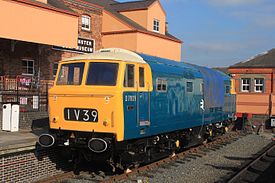Difference between revisions of "BR Class 35 D7029"
(→D7029 in Preservation: update) |
m (Diesel navbox) |
||
| Line 46: | Line 46: | ||
==Links== | ==Links== | ||
[http://www.westernchampion.co.uk/loco-d7029.php D7029 page on DTG web site] | [http://www.westernchampion.co.uk/loco-d7029.php D7029 page on DTG web site] | ||
| + | |||
| + | {{DieselNavbox}} | ||
Revision as of 23:15, 22 November 2016
| BRBritish Rail or British Railways Class 35 D7029 | |
|---|---|
 D7029 on static display at Kidderminster in 2015 | |
| Built By | Beyer Peacock, Gorton, |
| Configuration | B-B |
| Power type | Diesel Hydraulic |
| Status | Under overhaul |
| Loco Number | D7029 |
| History | |
| Built | 1962 |
| Designed By | Beyer Peacock (Hymek) Limited |
| Type | Class 35 |
| 1975 | Purchased by the Diesel Traction Group |
| 1981 | In service on NYMR |
| 1996 | Arrived on SVRSevern Valley Railway |
| 2000 | Sent to Old Oak Common for overhaul |
| 2005 | Returned from OOC |
| Technical | |
| Length | 51ft 8½" |
| Weight | 75t |
BRBritish Rail or British Railways Class 35
The BRBritish Rail or British Railways Class 35 was developed for British Railways Western Region ‘BRBritish Rail or British Railways(W)’ as a lightweight mixed traffic B-B locomotive used for both secondary passenger work and freight duties. The class became known as ‘Hymeks’ because of their Mekydro-designed hydraulic transmission. Built between 1961 and 1964, they saw use all over the Western region, including being used in multiple (up to three locomotives) as bankers on the notorious Lickey Incline.
Diesel-hydraulic locomotives were not generally favoured by BRBritish Rail or British Railways, and the class had only a short working life, being withdrawn between 1971 and 1975 when they were replaced by Class 37 diesel-electric locomotives.
D7029 in Service
D7029 was built by Beyer Peacock as Works No 7923 and entered traffic at Cardiff Canton in April 1962, working express trains from South Wales to London. Initially the locomotive was in BRBritish Rail or British Railways Green livery with yellow warning panels. After brief allocations to Plymouth Laira and Bristol Bath Road in 1967, D7029 moved to Old Oak Common in April 1968.
In March 1970 D7029 was damaged at both ends in a collision, requiring 2 months of repairs at Swindon. After repair including a repaint into BRBritish Rail or British Railways Blue livery with yellow ends, D7029 returned to Old Oak Common, regularly working services from Paddington to Worcester & Hereford as well as Oxford commuter services.
D7029 was finally withdrawn from service on 28th February 1975 after a working life of less than 13 years.
D7029 in Preservation
D7029 was purchased from Old Oak Common by the Diesel Traction Group (DTG). After restoration at several locations, the first passenger run in preservation took place in May 1981 at the North Yorkshire Moors Railway. Operations continued there until July 1987 when the locomotive was withdrawn from service and mothballed, requiring tyre turning and the air reservoirs re-certifying.
D7029 was moved by road to Kidderminster in March 1996 but was immediately stored in a siding. In May 2000 the DTG secured accommodation at Old Oak Common, and D7029 left the SVRSevern Valley Railway by road without having turned a wheel at the railway. The DTG decided that a complete strip down and overhaul was required due to the length of time out of service. In August 2005, D7029 returned to the Severn Valley Railway where, as of November 2016[update], the overhaul is still ongoing at Kidderminster.
See also
Diesel Locomotives
List of preservation groups
Links
| ||||||||||||||||||||||||||||||||||||||||||||||||||||||||||||||||||||||||